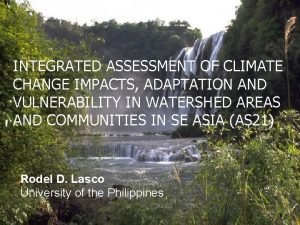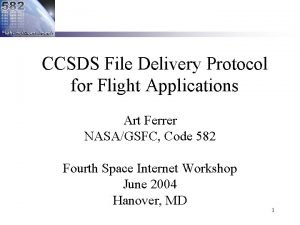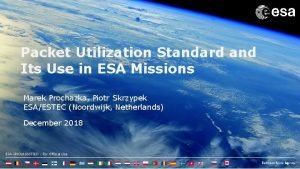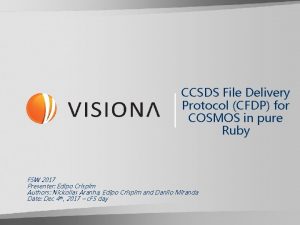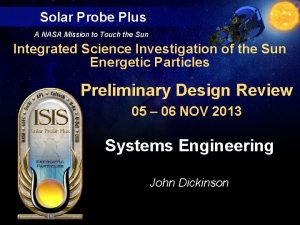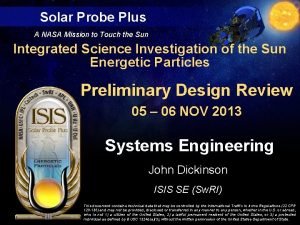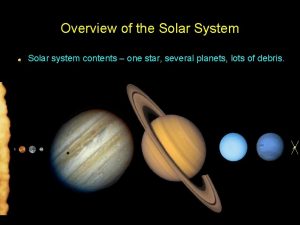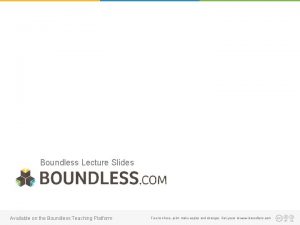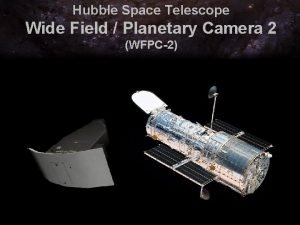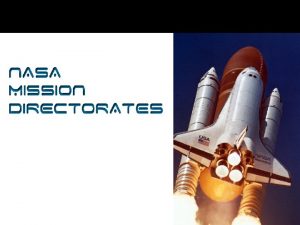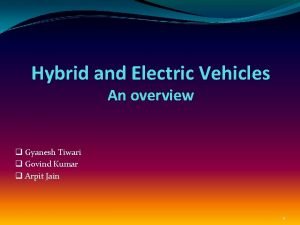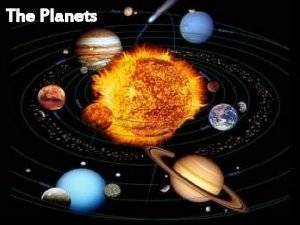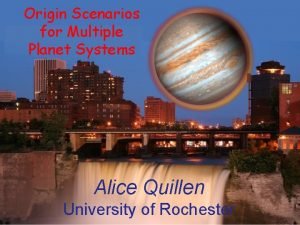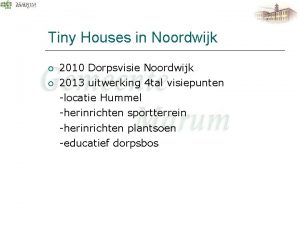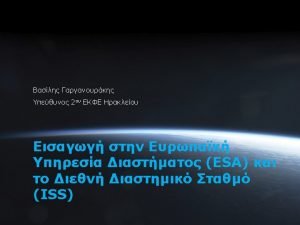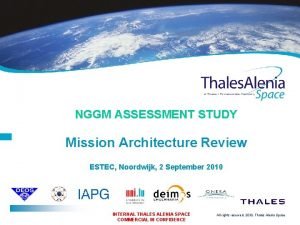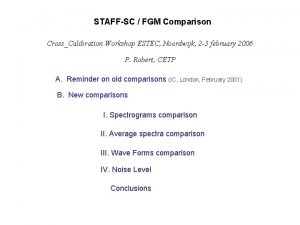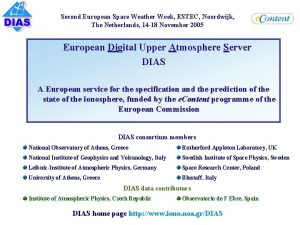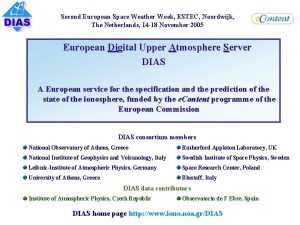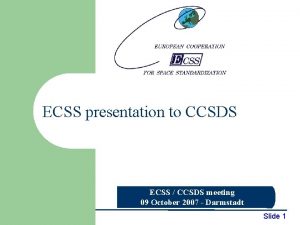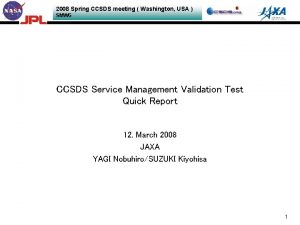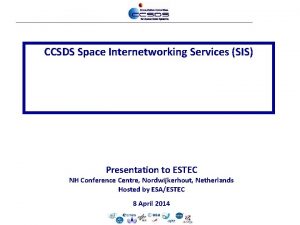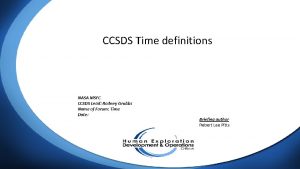CCSDS 2009 Fall Meeting ESTEC Noordwijk SLS Planetary












- Slides: 12

CCSDS 2009 Fall Meeting – ESTEC Noordwijk SLS Planetary Communications SIG Olivier Bompis / Jean-Luc Issler – October 30, 2009 SLS Pla. Com SIG – CCSDS Fall Meeting 09 – CNES DCT/RF/ITP /

SUMMARY ■ CNES proposal for Lunar and Martian Nav. Com surface links: w Martian / Lunar Surface Links Requirements & Main Objectives. w CNES Mission profiles definition. w Benefits of reusing Space-to-Earth (MSS+RDSS/RNSS) bands. w Advantages of reusing terrestrial standardised waveforms for Com surface and return emergency links. ■ CNES studies & tools around Lunar / Martian Nav. Com problematic: w Ph. D thesis on OFDM signal processing for GNSS. w Phase 0 study: Geophysical Package for Seismological Lunar Network. w Interference Assessment Software (Interference Analysis for Space Com Systems). SLS Pla. Com SIG – CCSDS Fall Meeting 09 – CNES DCT/RF/ITP 2

Martian / Lunar Surface Links Requirements (Overview) ■ Need to address several different components… à Autonomous surface stations and exploration vehicles (i. e. rovers). à Nav. Com relays on surface or in orbit (surface beacons or satellites). à Future human lunar outposts (NASA Constellation) with EVAs. ■ … and several different needs, for example: à Low data rate, severely power constrained links (ie. surface platforms). à High data rate, power spectrum constrained links (ie. Dat. Com for EVAs). à Provide time synchronisation, ranging, and localisation. à Ensure reliability and availability regarding constrained reception environment. Surface Beacon Data Relay Satellite Rover SLS Pla. Com SIG – CCSDS Fall Meeting 09 – CNES DCT/RF/ITP Outpost Pictures from ALICE SEEDS IV mission analysis and NASA JPL ALGEP-NG paper 3

CNES Mission profiles definition Primarily concerned with Surface & Proximity Links ■ Contribute to Lunar and Martian autonomous surface stations in providing geophysical instruments and Communications S/S for Surface Links (Around the International Lunar Network initiative). ■ Contribute to exploration Rovers in providing scientific equipment and Communication S/S for Surface Links (Chem. Cam on NASA Mars Science Laboratory, Proximity-1 Link intended on ESA EXOMARS). EXOMARS Landing Platform Configuration UHF Band Transponder CHEMCAM Mast Unit UHF Band Transponder Very Broadband Seismologic Sensor SLS Pla. Com SIG – CCSDS Fall Meeting 09 – CNES DCT/RF/ITP Proximity-1 Link « SMART UHF » for future robots or surface Platform 4

Benefits of reusing (MSS + RDSS/RNSS) Bands ■ Observe tendencies of current Terrestrial Radionavigation Satellite Service (RDSS/RNSS) to extend from L-Band to S-Band (cf. next WRC 2012 to open MSS bands for RDSS/RNSS to Europe/Africa & the Americas, in addition to Asia/Australia, where this dual attribution is already in place Worldwide convergence between MSS & RDSS/RNSS). ■ The S-Band spectrum between 2483. 5 and 2500 MHz (Mobile Satellite Services) can be reused for GNSS to allow interesting synergies with communications systems (cf. I. Mateu & al , “Exploration of Possible GNSS Signals in S-band”, ION GNSS September 2009: Session C 5 Paper #7). ■ These should produce only in this band natural development of affordable RF components / receivers which provide both Radionavigation / Time synchronisation & data / voice communication capabilities (i. e. future GLOBALSTAR mobile phones with RNSS). ■ Applicability on Lunar / Mars Vicinity Frequency Plans ? Needs to be addressed separately from CCSDS SLS Pla. Com SIG (SFCG – LMSCG attributes). SLS Pla. Com SIG – CCSDS Fall Meeting 09 – CNES DCT/RF/ITP 5

Advantages of reusing terrestrial standardized waveforms ■ For Communication Surface Links: à Standard use of OFDM modulation such as Wi. Max or DVB-SH should interest candidates to provide Communication capabilities for several actors on the surfaces of the Moon or Mars (robustness against multipath produced by constrained environment). à These waveforms allow Radionavigation and Time synchronisation capabilities considering the merge of (MSS + RDSS/RNSS) frequency bands (cf. next slides on OFDM signal processing for pseudo-range measurements). à Allows a simple adaptation, reliable, and affordable components well-sustained by international manufacturers. ■ For Return Emergency Links (manned missions needs): à Coupled with previous communication surface links, Return Emergency Links based on CDMA allocation (i. e. GLOBALSTAR IS-95 derived signal) allow us to adapt simple, reliable and affordable components used for terrestrial applications. à OFDM modulation could also provide the same advantage. Preliminary proposals ; to be discussed SLS Pla. Com SIG – CCSDS Fall Meeting 09 – CNES DCT/RF/ITP 6

CNES Ph. D Thesis on OFDM signal processing for GNSS ■ Thesis Objectives w Determine signal processing techniques on OFDM modulation for positioning (pseudo-range measurements). w Focus on DVB-T/-H/-SH family signals standards. ■ Thesis Contents w Propose a specific method for pseudo-range measurements in multipath propagation channels based on pilot symbols of DVB-T family signals. w Evaluate method’s performances in realistic propagation channels, with low SNR conditions. ■ Main Conclusion w A RDSS system using OFDM instead of DSSS/CDMA could provide comparable pseudo range measurements with an efficient use of available bandwidth and provide communication service. SLS Pla. Com SIG – CCSDS Fall Meeting 09 – CNES DCT/RF/ITP 7

CNES Ph. D Thesis on OFDM signal processing for GNSS ■ Contents (details): w Benefits in using the DVB-SH standard with OFDM access technique for providing positioning function with TDOA (from P. Thevenon & al “Positioning principles with a mobile TV system using DVB-SH signals and a Single Frequency Network”, Digital Signal Processing, 2009 16 th International Conference). w Performance on pseudo range accuracy is comparable to that of CDMA with a similar bandwidth. Multipath error on ranging is limited vs. GPS C/A. Parameters: - 2048 FFT size (2 K mode). - Signal BW: 5 MHz. - Loop noise BW: 10 Hz. - Amplitude (2 nd path) = 0. 5 * LOS. SLS Pla. Com SIG – CCSDS Fall Meeting 09 – CNES DCT/RF/ITP 8

CNES Phase 0 Study: Seismological Lunar Network ■ Study Objectives w Build-up a core station to perform seismologic analysis on lunar surface. w High constraint on available power (using solar energy only). w Analyse communications scenarios (DTE / Relay) depending stations locations. ■ Study Contents w Trade-Off between S-Band for DTE-DFE/Relay and UHF for Relay links. w Links and Power budgets which allow optimal configuration. ■ Results & Improvements w Potential interest to use an “hybrid” S-Band design for DTE and Relay links. w Frequency bands : potential interest of « popular » wireless designs (GSM / IEEE 802. 11 – 802. 16 standards) for proximity surface links. w Modulations / Coding schemes: performance analysis of LDPC AR 4 JA vs. CCSDS Turbo-Coding. w Next Steps: Lunar and Mars “Communication & Navigation” Infrastructure Design (2010 prospective phase 0 study) + CNES membership in inter-agencies working groups on Nav. Com aspects (CCSDS Pla. Com SIG, ILN WG 02). SLS Pla. Com SIG – CCSDS Fall Meeting 09 – CNES DCT/RF/ITP 9

Interference Assessment Software: what is available ? ■ Developed in C under JUZZLE environment w Modularity (libraries and computation blocks). w Compatibility with WINDOWS and LINUX. w User-friendly interface. ■ Models available w Orbit propagator J 2 (CNES MSLIB 90 free library) in line with “Calculation of GPS and GALILEO Satellite Positions in ECEF Coordinates” Informal note form US RFC Subgroup Team, 29 June 2006. w Orbit propagator SGP 4 / SDP 4. w CNES DCT/RF/ITP propagation DLL, referenced at ITU. w Link budget and SSC calculus. ■ Scenario set-up w Possibility to set-up any constellation based on TLE or on Kepler parameters. w Possibility to set-up any user-defined antenna radiation pattern ( , gain). w Possibility to set-up any user-defined spectrum. w Possibility to define precise surface station location or a grid of receivers. SLS Pla. Com SIG – CCSDS Fall Meeting 09 – CNES DCT/RF/ITP 10

Comparisons between IAS and other RFC group tools ■ Link budget comparisons have been done between IAS results and Uni. BW tool results w Received power show an offset of 0. 85 d. B for GPS PRN 1 satellite. w Received power show an offset of 0. 93 d. B for Galileo PRN 51 satellite. SLS Pla. Com SIG – CCSDS Fall Meeting 09 – CNES DCT/RF/ITP 11

Thank you for your attention SLS Pla. Com SIG – CCSDS Fall Meeting 09 – CNES DCT/RF/ITP 12
